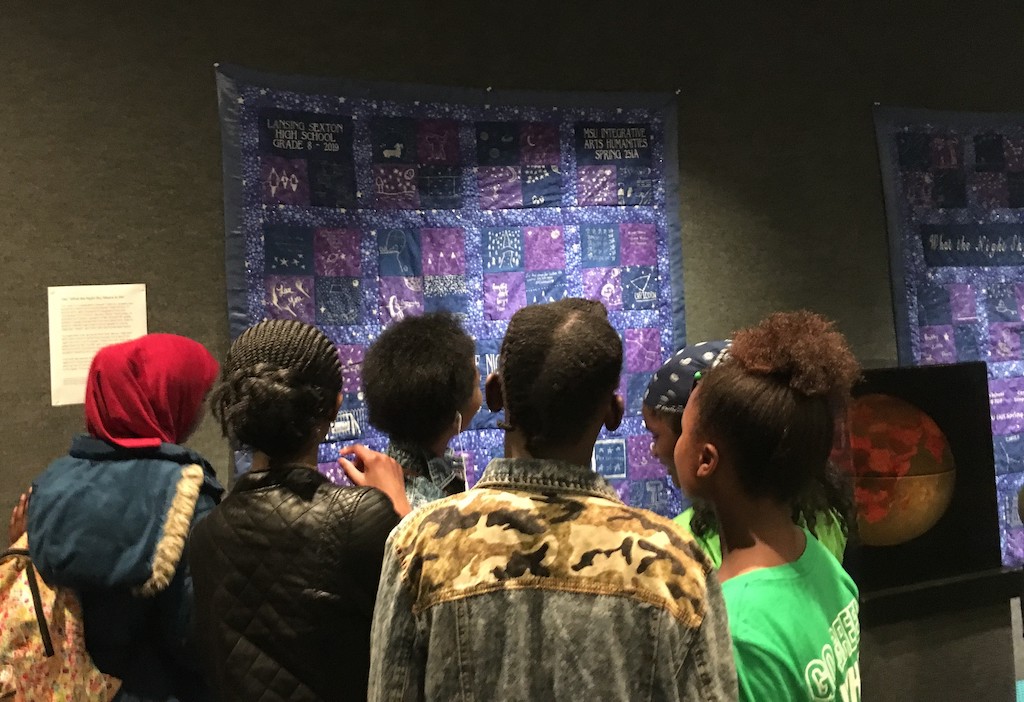Ellen Moll, an Academic Specialist in the Center of Integrated Studies in the Arts and Humanities (IAH), led almost 50 students from across the university this past semester in a course that provided civic engagement and gave students the opportunity to create materials for the MSU Planetarium.
The specific course, Human Values in the Arts & Humanities (IAH 231A), had students working with each other and with middle school students from Lansing Sexton High School to create engaging and inclusive materials for the MSU Planetarium’s lobby. The purpose of the project was to come up with novel interactive displays on a range of topics regarding science or the history of science.
Using an arts and humanities approach to how we think about science and space exploration, the students covered a variety of topics, including how different cultures name or find meaning in constellations and how the human body changes in space. The Planetarium now will choose what materials to display in their lobby.
Everyone needs to be able to think about what it means to be human and act ethically, both in your job and other aspects of your life.
ELLEN MOLL, ACADEMIC SPECIALIST
“I tried to get the students to think more about what we think the purpose of the arts and humanities is and how that kind of thinking applies to every type of topic, including science,” Moll said. “It’s not just about the content, it’s about how you bring different types of knowledge together. This is something that is so important to the humanities since we are always looking for ways to integrate more perspectives into our world view.”
IAH courses encourage students to engage critically with society, history, and culture. All MSU students are required to take two IAH courses as part of their general education requirements. The goal of the curriculum is to not only expose students to the arts and humanities, but also to prepare them for the complex world in which they live and in which they will pursue their careers after they graduate from MSU.
“Everyone needs to be able to think about what it means to be human, both in your job and other aspects of your life,” Moll said. “The arts and humanities are about culture and creativity and acting thoughtfully and ethically, and about these bigger questions that apply to all of us.”

The middle school students who participated in the Planetarium project took a few field trips to MSU to visit the Planetarium, to interact with the students in Moll’s class, and to offer feedback on the IAH 231A projects. These field trips were in part supported by Communities in Schools, an organization that works with schools specifically to coordinate collaborations with others in the community. Some aspects of the projects were part of a larger effort founded by the Planetarium director, Dr. Shannon Schmoll, and Professor Georgina Montgomery, to diversify the lobby materials in the Planetarium. Additional support was provided by the College of Arts & Letters, Lilly Fellows, and the students’ middle school teacher, Mary Lisa Konett.
The middle school students also attended a mentorship lunch where they learned more about college, opportunities that may be available to them, and potential career/life interests. Additionally, these eighth-grade students served as focus groups for the MSU students who visited Lansing Sexton High School while developing their Planetarium projects. But the eighth-graders were not the only ones to benefit from this relationship. The MSU students learned how to mentor youth and engage community members.
The humanities are about being human and about culture and how that applies to all of us.
ELLEN MOLL, ACADEMIC SPECIALIST
“My students pitched them their project ideas and the eighth-grade students gave feedback,” Moll said. “And so the eighth graders helped the MSU students with their projects, which was cool. Both sides were helping and learning from each another.”
On April 18, the middle school students came to MSU one last time to see the unveiling of a quilt that they worked on together with the MSU students. Each square of the quilt shows either a drawing or a few sentences that describe each student’s favorite thing about the night sky.

“It’s been a really good learning experience in terms of combining those arts and humanities skills that the students learned in this class with the understanding of their real-world audience,” Moll said. “They were also able to reflect on the process, and they considered how this course will influence what they want to do with their lives or careers and what they got out of their service learning in the long term.”
Moll encourages other students and faculty members to take advantage of MSU’s visibility in the community.
“[The College of Arts & Letters] can answer the question, ‘what can the arts and humanities do for the world?’ Whether that’s IAH, the digital humanities, the Citizen Scholars program, WOCI’s (Womxn of Color Initiatives) mural in old town, or the many other faculty who engage the community,” Moll said. “We have that reputation in the community and the College values it.”
